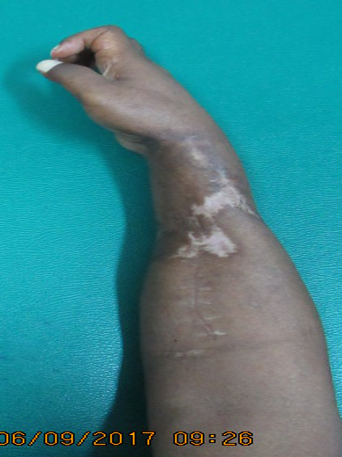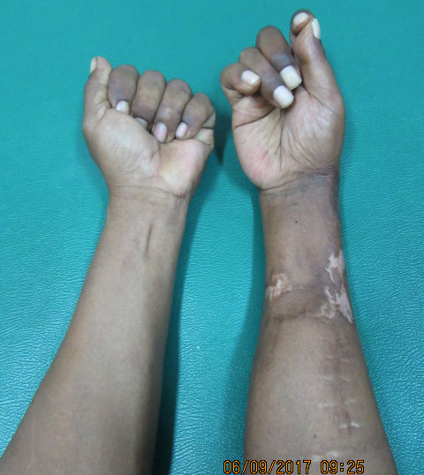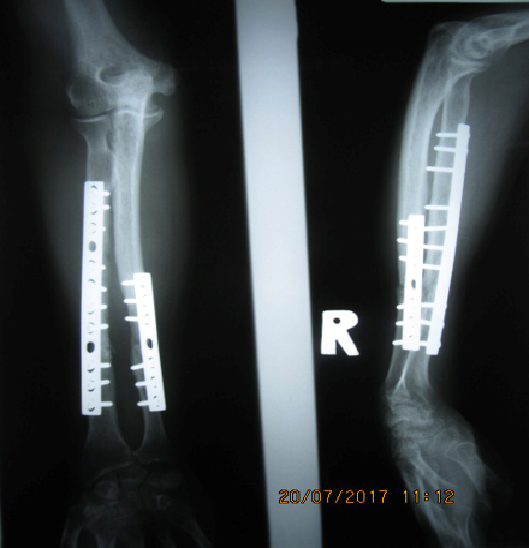


History: 53 year old male fell in March 2016 sustaining an injury to his right forearm. He was treated with KTM and a bamboo splint was applied. It is not clear when he developed compartment syndrome (Volkmann’s ischeamic contracture) but six weeks later the patient had an ORIF at Kong Each Clinic. He presented to CSC in July 2017 with the deformity in the photographs and the x-ray as shown.
Dr Saqib: Learning point 1: Volkmann’s ischaemic contracture is a description of compartment syndrome in the forearm. Compartment syndrome is an emergency and before discussing chronic compartment syndrome, it is important to understand acute compartment syndrome. When acute compartment syndrome is not treated, severe complications can occur which are very difficult to treat in the future. Please watch this video to learn about acute compartment syndrome.
Remember in acute compartment syndrome, it only takes 6 hours for the muscle to become irreversibly ischaemic. Pain is the first and most sensitive sign so any patient at risk of compartment syndrome presenting with severe pain must be urgently evaluated. At CSC, this is most likely to be post op if a patient has had recent surgery.
Dr Saqib: Learning point 2: It is important to know how to manage acute compartment syndrome and if necessary where to make the incisions for fasciotomy. This article gives a good overview for management including fasciotomies.
Once chronic cases occur, like our patient, it is very important to do full assessment of the patient’s function. It is important to understand the patient’s job, their hand dominance, and what functions of living the patient can and cannot do. This will help you determine treatment plans. Also, when you examine the patient, document what active and passive movements the patient has in all the joints – in this case, you must include full description of movements in the elbow, wrist and fingers.
Dr Saqib: Learning point 3: Please look at the following diagrams to learn how to describe the angles for range of motion in the fingers and wrist.
Finger range of motion
Wrist range of motion (flexion / extension)
Wrist range of motion (ulna/radial deviation)
Our patient at CSC did not have any description of range of motion, passively or actively.
Also it is important to assess the nerve function. For full advice on how to do an examination, follow this link and read more.
To understand compartment syndrome in the forearm, it is good to know the anatomy. This video describes the anatomy and Volkmann’s ischaemic contracture in the forearm.
Dr Saqib: Learning point 4: Once you have got chronic compartment syndrome in the forearm, the outcomes are not favourable. Volkmann’s contracture can be classified into three types on the basis of clinical findings relating to the severity
of the process.
Mild — contracture of 2 or 3 fingers only, with no or limited loss of feeling
Moderate — all fingers are bent (flexed) and the thumb is stuck in the palm; the wrist may be bent stuck, and there is usually loss of some feeling in the hand
Severe — all muscles in the forearm that both flex and extend the wrist and fingers are involved; this is a severely disabling condition. There is significant lack of sensation and motor function.
It is likely our case at CSC is in the moderate category.
Treatment can be defined as follows:
Mild: Dynamic splinting, physical therapy, tendon lengthening and slide procedure
Moderate: Tendon slide, neurolysis (M and U), and extensor transfer procedures
Severe: More extensive and radical intervention is required, often involving extensive debridement of damaged muscle with multiple releases of scar tissue and salvaging procedures. However, surgery in the severe cases may not be recommended as results are often bad.
You can read more articles about treatment here:
Treatment of Established Volkmann’s Contracture*
BY KENYA TSUGE, M.D.’J’, HIROSHIMA, JAPAN
From the Department of Orthopaedic Surgery, Hiroshima Universi~.’
School of Medicine, Hiroshima
[gview file=”http://teaching.csc.org/wp-content/uploads/2017/09/11000172.pdf”]
Classification of Established Volkmann’s Ischemic Contracture and the Program for Its Treatment
[gview file=”http://teaching.csc.org/wp-content/uploads/2017/09/11000173.pdf”]